Pervaporation Membranes for Seawater Desalination Based on Geo–rGO–TiO2 Nanocomposites: Part 2—Membranes Performances
Abstract
1. Introduction
2. Materials and Methods
3. Results and Discussion
3.1. The Membrane Performance and Desalination Results
3.2. FTIR Characterization
3.3. XRD Characterization
3.4. SEM–EDS Examinations
4. Conclusions
Author Contributions
Funding
Institutional Review Board Statement
Informed Consent Statement
Data Availability Statement
Acknowledgments
Conflicts of Interest
References
- Liu, G.; Jin, W. Pervaporation membrane materials: Recent trends and perspectives. J. Memb. Sci. 2021, 636, 119557. [Google Scholar] [CrossRef]
- Mahmoud, K.A.; Mansoor, B.; Mansour, A.; Khraisheh, M. Functional graphene nanosheets: The next generation membranes for water desalination. Desalination 2015, 356, 208–225. [Google Scholar] [CrossRef]
- Yang, Z.; Ma, X.H.; Tang, C.Y. Recent development of novel membranes for desalination. Desalination 2018, 434, 37–59. [Google Scholar] [CrossRef]
- Wang, J.; Tanuwidjaja, D.; Bhattacharjee, S.; Edalat, A.; Jassby, D.; Hoek, E.M.V. Produced water desalination via pervaporative distillation. Water 2020, 12, 3560. [Google Scholar] [CrossRef]
- Li, X.; Qu, Y.; Wang, X.; Bian, H.; Wu, W.; Dai, H. Flexible graphene/silver nanoparticles/aluminum film paper for high-performance electromagnetic interference shielding. Mater. Des. 2022, 213, 110296. [Google Scholar] [CrossRef]
- Qian, X.; Li, N.; Wang, Q.; Ji, S. Chitosan/graphene oxide mixed matrix membrane with enhanced water permeability for high-salinity water desalination by pervaporation. Desalination 2018, 438, 83–96. [Google Scholar] [CrossRef]
- Wu, D.; Gao, A.; Zhao, H.; Feng, X. Pervaporative desalination of high-salinity water. Chem. Eng. Res. Des. 2018, 136, 154–164. [Google Scholar] [CrossRef]
- Zhao, P.; Xue, Y.; Zhang, R.; Cao, B.; Li, P. Fabrication of pervaporation desalination membranes with excellent chemical resistance for chemical washing. J. Memb. Sci. 2020, 611, 118367. [Google Scholar] [CrossRef]
- Alves, E.; Oliveira, A.; Plácido, A.; Socodato, R.; Carolina, A.; Ombredane, A.S.; Moreira, D.C.; Vale, N.; Bessa, L.J.; Joanitti, G.A.; et al. Structure and function of a novel antioxidant peptide from the skin of tropical frogs. Free Radic. Biol. Med. 2018, 115, 68–79. [Google Scholar] [CrossRef]
- Wee, S.L.; Tye, C.T.; Bhatia, S. Membrane separation process pervaporation through zeolite membrane. Sep. Purif. Technol. 2008, 63, 500–516. [Google Scholar] [CrossRef]
- Goh, P.S.; Ismail, A.F. A review on inorganic membranes for desalination and wastewater treatment. Desalination 2018, 434, 60–80. [Google Scholar] [CrossRef]
- Meng, J.; Zhao, P.; Cao, B.; Lau, C.H.; Xue, Y.; Zhang, R.; Li, P. Fabricating thin-film composite membranes for pervaporation desalination via photo-crosslinking. Desalination 2021, 512, 115128. [Google Scholar] [CrossRef]
- Goh, P.S.; Matsuura, T.; Ismail, A.F.; Hilal, N. Recent trends in membranes and membrane processes for desalination. Desalination 2016, 391, 43–60. [Google Scholar] [CrossRef]
- Prihatiningtyas, I.; Gebreslase, G.A.; Van der Bruggen, B. Incorporation of Al2O3 into cellulose triacetate membranes to enhance the performance of pervaporation for desalination of hypersaline solutions. Desalination 2020, 474, 114198. [Google Scholar] [CrossRef]
- Wang, C.; Park, M.J.; Yu, H.; Matsuyama, H.; Drioli, E.; Shon, H.K. Recent advances of nanocomposite membranes using layer-by-layer assembly. J. Memb. Sci. 2022, 661, 120926. [Google Scholar] [CrossRef]
- Li, X.; Zhu, B.; Zhu, J. Graphene oxide based materials for desalination. Carbon 2019, 146, 320–328. [Google Scholar] [CrossRef]
- Huang, L.; Zhao, S.; Wang, Z.; Wu, J.; Wang, J.; Wang, S. In situ immobilization of silver nanoparticles for improving permeability, antifouling and anti-bacterial properties of ultrafiltration membrane. J. Memb. Sci. 2016, 499, 269–281. [Google Scholar] [CrossRef]
- Andreozzi, M.; Álvarez, M.G.; Contreras, S.; Medina, F.; Clarizia, L.; Vitiello, G.; Llorca, J.; Marotta, R. Treatment of saline produced water through photocatalysis using rGO-TiO2 nanocomposites. Catal Today 2018, 315, 194–204. [Google Scholar] [CrossRef]
- Prihatiningtyas, I.; Van der Bruggen, B. Nanocomposite pervaporation membrane for desalination. Chem. Eng. Res. Des. 2020, 164, 147–161. [Google Scholar] [CrossRef]
- He, Y.; Wang, Z. Preparation of nano-composites membranes with graphic oxides and polylactic acid. J. Wuhan Univ. Technol.-Mat. Sci. Ed. 2018, 33, 995–998. [Google Scholar] [CrossRef]
- Abukhadra, M.R.; Eid, M.H.; El-Sherbeeny, A.M.; Abd Elgawad, A.E.E.; Shim, J.J. Effective desalination of brackish groundwater using zeolitized diatomite/kaolinite geopolymer as low-cost inorganic membrane; Siwa Oasis in Egypt as a realistic case study. J. Contam. Hydrol. 2022, 244, 103923. [Google Scholar] [CrossRef] [PubMed]
- Subaer, S.; Fansuri, H.; Haris, A.; Misdayanti; Irfanita, R.; Ramadhan, I.; Putri, Y.; Setiawan, A. Pervaporation membranes for seawater desalination based on Geo–rGO–TiO2 nanocomposites. Part 1: Microstructure properties. Membranes 2021, 11, 966. [Google Scholar] [CrossRef] [PubMed]
- Yan, S.; He, P.; Jia, D.; Yang, Z.; Duan, X.; Wang, S.; Zhou, Y. Effects of treatment temperature on the reduction of GO under alkaline solution during the preparation of graphene/geopolymer composites. Ceram. Int. 2016, 42, 18181–18188. [Google Scholar] [CrossRef]
- Li, M.; Luo, R.; Qin, L.; Liu, H.; Duan, P.; Jing, W.; Zhang, Z.; Liu, X. High temperature properties of graphene oxide modified metakaolin based geopolymer paste. Cem. Concr. Compos. 2022, 125, 104318. [Google Scholar] [CrossRef]
- World Health Organization. Water Quality and Health–Review of Turbidity: Information for regulators and water suppliers. Available online: https://apps.who.int/iris/handle/10665/254631 (accessed on 18 August 2022).
- Longhi, M.A.; Rodríguez, E.D.; Walkley, B.; Eckhard, D.; Zhang, Z.; Provis, J.L.; Kirchheim, A.P. Metakaolin-based geopolymers: Efflorescence and its effect on microstructure and mechanical properties. Ceram. Int. 2022, 48, 2212–2229. [Google Scholar] [CrossRef]
- Wu, B.; Li, L.; Deng, H.; Zheng, Z.; Xiang, Y.; Li, Y.; Ma, X. Characteristics and mechanism of efflorescence in fly ash-based geopolymer mortars under quasi-natural condition. J. Build Eng. 2022, 55, 104708. [Google Scholar] [CrossRef]
- Simão, L.; Fernandes, E.; Hotza, D.; Ribeiro, M.J.; Montedo, O.R.K.; Raupp-Pereira, F. Controlling efflorescence in geopolymers: A new approach. Case Stud. Constr. Mater. 2021, 15, e00740. [Google Scholar] [CrossRef]
- Longhi, M.A.; Zhang, Z.; Walkley, B.; Rodríguez, E.D.; Kirchheim, A.P. Strategies for control and mitigation of efflorescence in metakaolin-based geopolymers. Cem. Concr. Res. 2021, 144, 106431. [Google Scholar] [CrossRef]
- Khajavi, S.; Jansen, J.C.; Kapteijn, F. Production of ultra pure water by desalination of seawater using a hydroxy sodalite membrane. J. Memb. Sci. 2010, 356, 52–57. [Google Scholar] [CrossRef]
- Ayeni, O.; Onwualu, A.P.; Boakye, E. Characterization and mechanical performance of metakaolin-based geopolymer for sustainable building applications. Constr. Build Mater. 2021, 272, 121938. [Google Scholar] [CrossRef]
- Liu, Y.; Lu, M.; Wu, K.; Yao, S.; Du, X.; Chen, G.; Zhang, Q.; Liang, L.; Lu, M. Anisotropic thermal conductivity and electromagnetic interference shielding of epoxy nanocomposites based on magnetic driving reduced graphene oxide@Fe3O4. Compos Sci. Technol. 2019, 174, 1–10. [Google Scholar] [CrossRef]
- Wan, Q.; Rao, F.; Song, S.; Zhang, Y. Immobilization forms of ZnO in the solidification/stabilization (S/S) of a zinc mine tailing through geopolymerization. J. Mater. Res. Technol. 2019, 8, 5728–5735. [Google Scholar] [CrossRef]
- Maiti, M.; Sarkar, M.; Maiti, S.; Malik, M.A.; Xu, S. Modification of geopolymer with size controlled TiO2 nanoparticle for enhanced durability and catalytic dye degradation under UV light. J. Clean. Prod. 2020, 255, 120183. [Google Scholar] [CrossRef]
- Feng, B.; Liu, J.; Chen, Y.; Tan, X. Zhang, M. Sun, Z. Properties and microstructure of self-waterproof metakaolin geopolymer with silane coupling agents. Constr. Build. Mater. 2022, 342, 128045. [Google Scholar] [CrossRef]
- Zhang, S.L.; Qi, X.Q.; Guo, S.Y.; Ren, J.; Chen, J.Z.; Chi, B.; Wang, X.C. Effect of a novel hybrid TiO2-graphene composite on enhancing mechanical and durability characteristics of alkali-activated slag mortar. Constr. Build. Mater. 2021, 275, 122154. [Google Scholar] [CrossRef]
- Geng, C.; Zhao, F.; Wang, Q.; Zheng, S.; Liu, Y.; Niu, H. Anti-biofouling property and anti-leaching investigation of modifier for PVDF ultrafiltration membrane by incorporating antibacterial graphene oxide derivatives. J. Environ. Chem. Eng. 2022, 10, 108558. [Google Scholar] [CrossRef]
- El-Bery, H.M.; Matsushita, Y.; Abdel-moneim, A. Fabrication of efficient TiO2-RGO heterojunction composites for hydrogen generation via water-splitting: Comparison between RGO, Au and Pt reduction sites. Appl. Surf. Sci. 2017, 423, 185–196. [Google Scholar] [CrossRef]
- Saafi, M.; Tang, L.; Fung, J.; Rahman, M.; Liggat, J. Enhanced properties of graphene/fly ash geopolymeric composite cement. Cem. Concr. Res. 2015, 67, 292–299. [Google Scholar] [CrossRef]
- Jin, M.; Wang, Z.; Lian, F.; Zhao, P. Freeze-thaw resistance and seawater corrosion resistance of optimized tannery sludge/metakaolin-based geopolymer. Constr. Build. Mater. 2020, 265, 120730. [Google Scholar] [CrossRef]
- Zhang, M.; Xu, H.; Phalé Zeze, A.L.; Liu, X.; Tao, M. Coating performance, durability and anti-corrosion mechanism of organic modified geopolymer composite for marine concrete protection. Cem. Concr. Compos. 2022, 129, 104495. [Google Scholar] [CrossRef]

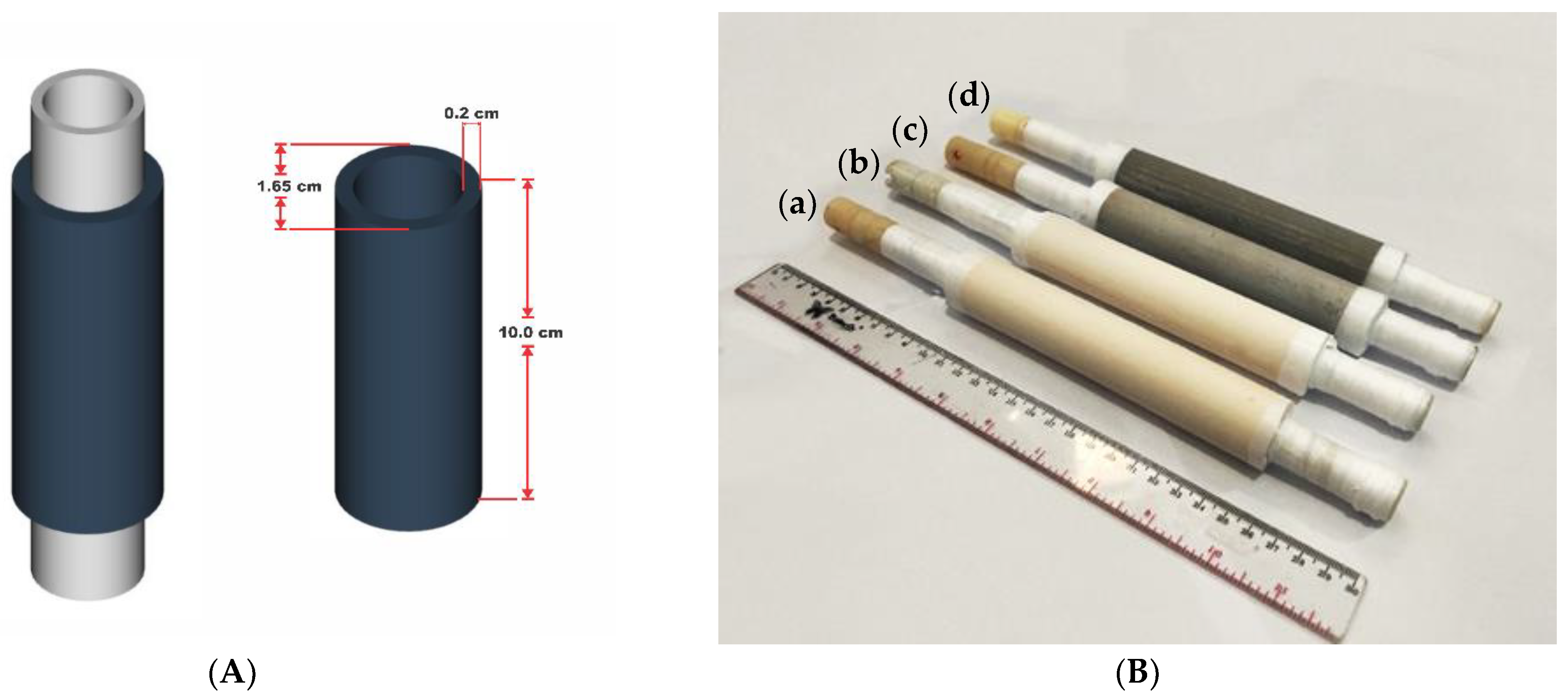



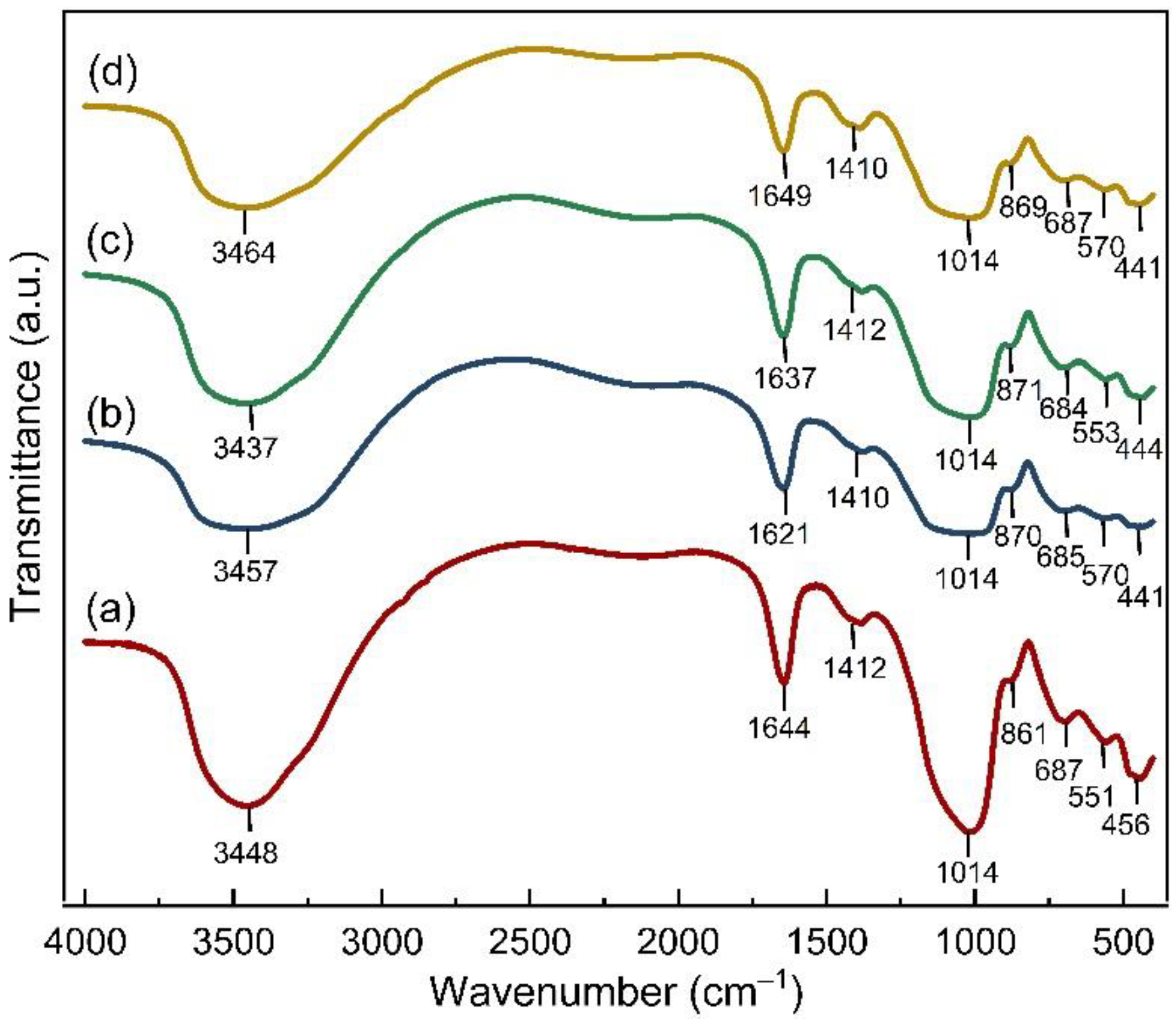
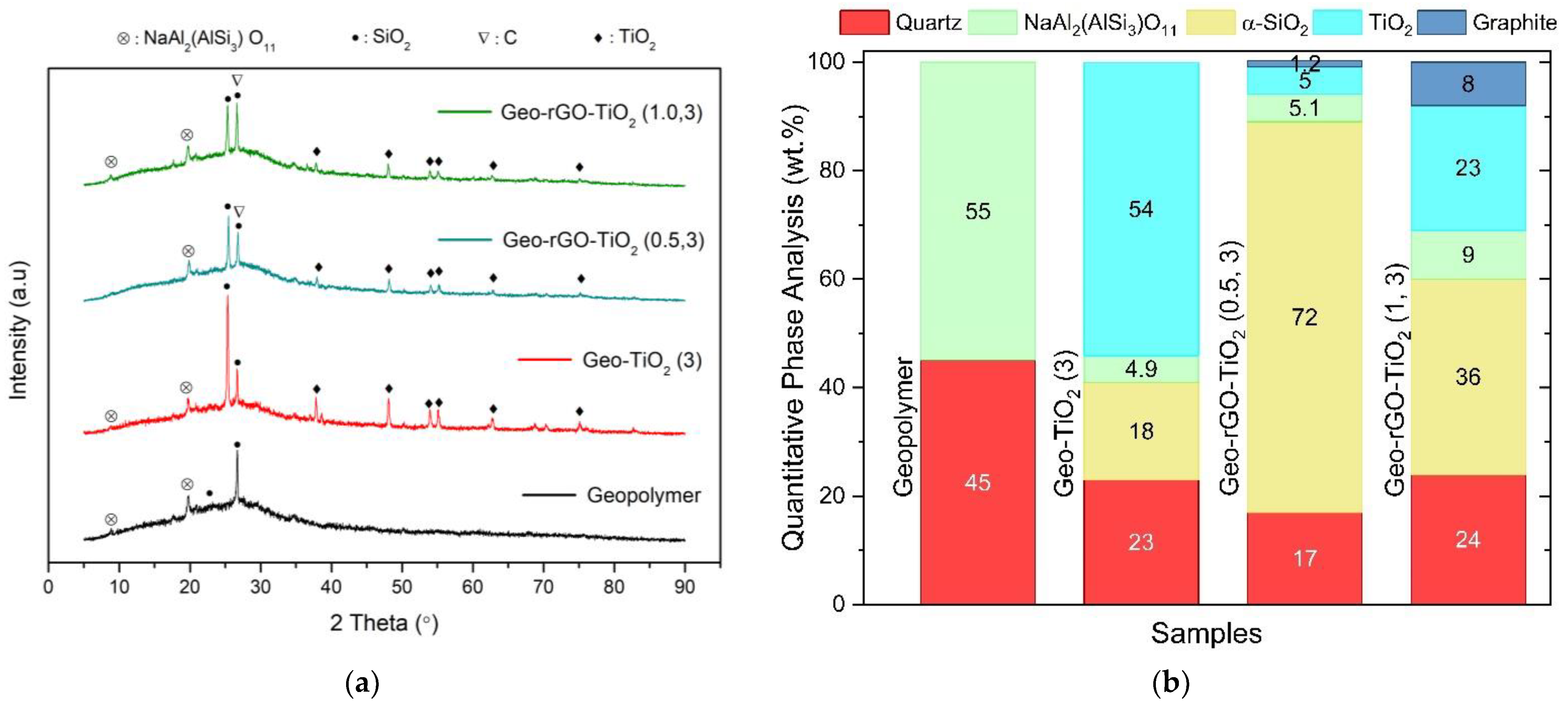
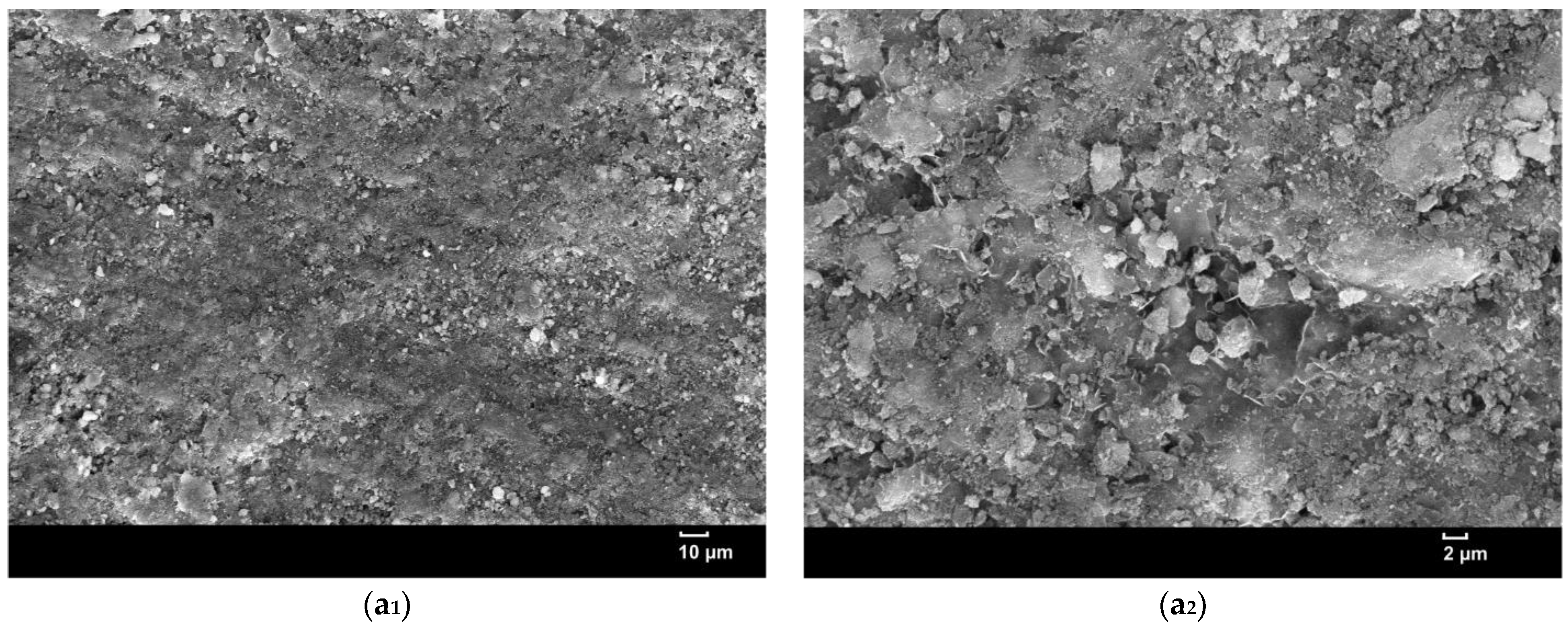

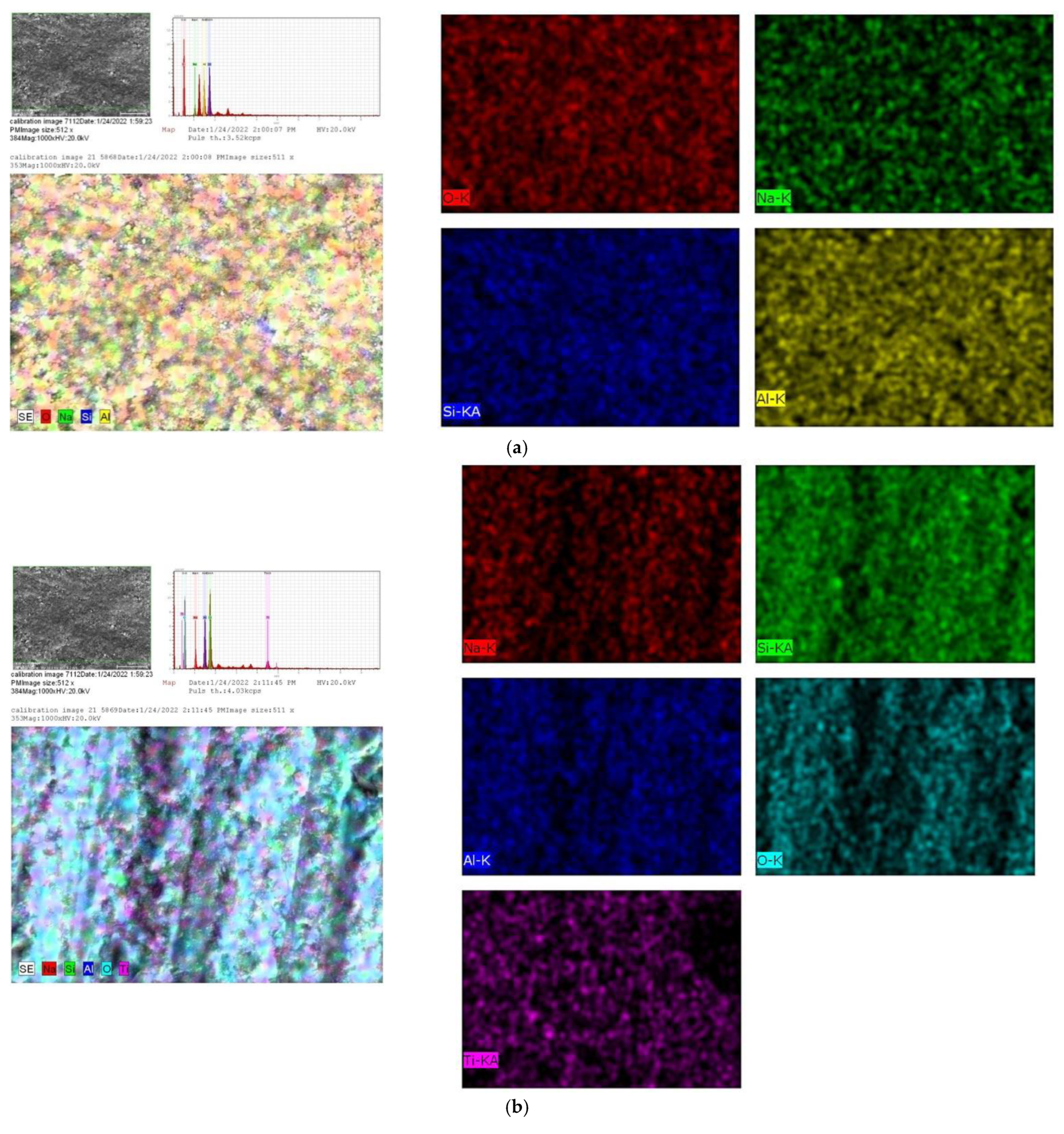

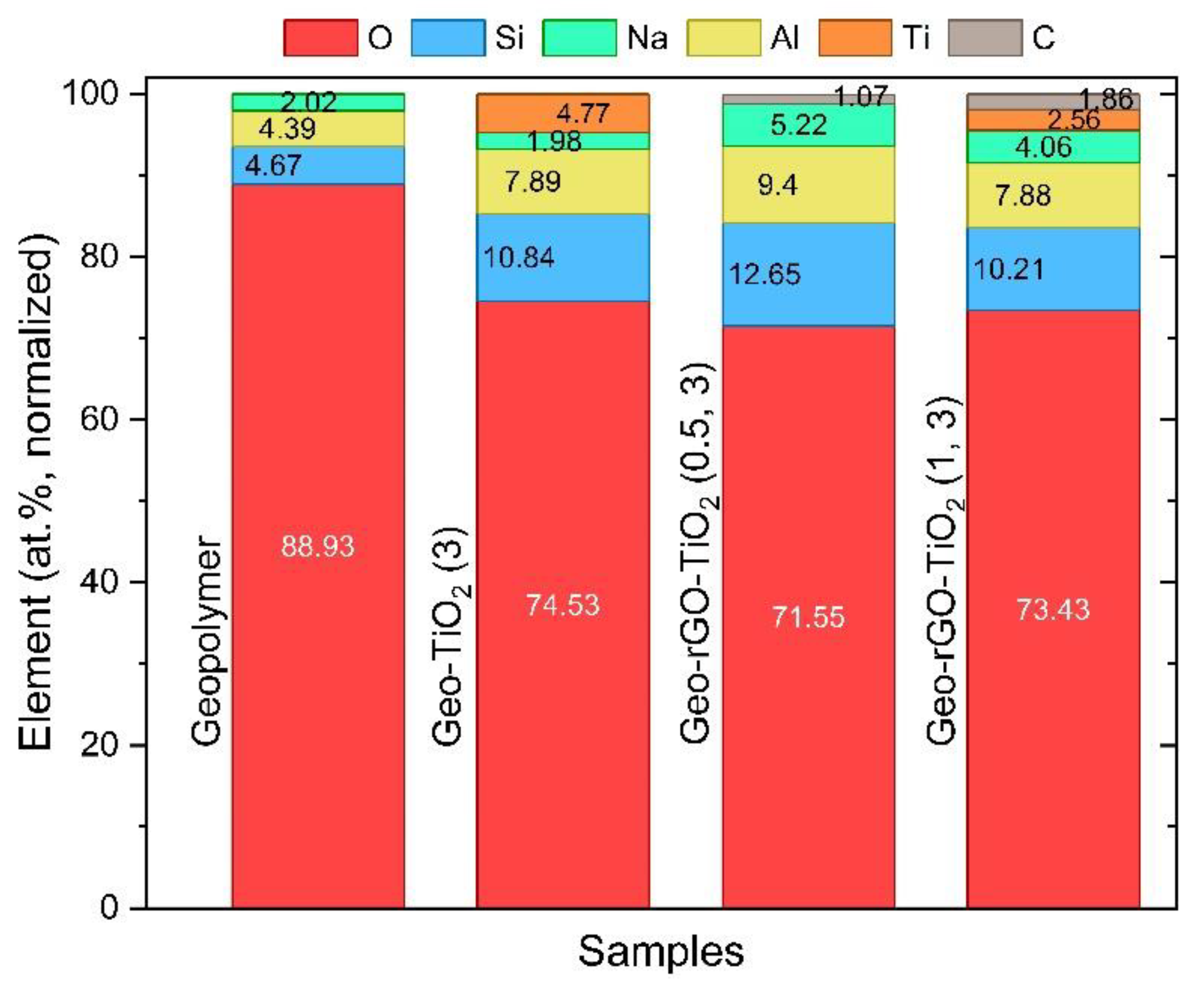
| Sample | Metakaolin | NaOH | Na2OSiO3 | H2O | rGO | TiO2 |
|---|---|---|---|---|---|---|
| Geopolymer | 30 | 3 | 24 | 9 | 0 | 0 |
| Geo–TiO2 (3) | 30 | 3 | 24 | 9 | 0 | 3 |
| Geo–rGO–TiO2 (0.5, 3) | 30 | 3 | 24 | 9 | 0.5 | 3 |
| Geo–rGO–TiO2 (1, 3) | 30 | 3 | 24 | 9 | 1.0 | 3 |
| Membrane | Flux (kg/m2·h) | Pervaporation Time (h) |
|---|---|---|
| Geopolymer | 5.29 | 47.5 |
| Geo–TiO2 (3) | 8.06 | 31.2 |
| Geo–rGO–TiO2 (0.5, 3) | 0.92 | 273 |
| Geo–rGO–TiO2 (1, 3) | 2.29 | 109 |
| Seawater/Permeate of the Membranes | Flux (kg/m2·h) | Turbidity (NTU) | Salinity (ppt) | TSS (mg/L) | EC (mS/cm) | Rejection (%) | pH |
|---|---|---|---|---|---|---|---|
| Seawater | - | 26.2 ± 0.26 | 30.25 ± 0.30 | 25.0 ± 0.50 | 38.2 ± 2.29 | - | 7.12 ± 0.01 |
| Geopolymer | 5.29 ± 0.50 | 0.14 ± 0.01 | 9.72 ± 0.10 | 37.5 ± 0.75 | 18.30 ± 1.10 | 52.09 ± 1.04 | 7.72 ± 0.01 |
| Geo–TiO2 (3) | 8.06 ± 0.59 | 0.82 ± 0.02 | 7.77 ± 0.08 | 31.5 ± 0.63 | 14.68 ± 0.88 | 63.32 ± 1.27 | 7.60 ± 0.01 |
| Geo–rGO–TiO2(0.5, 1) | 0.92 ± 0.40 | 0.82 ± 0.02 | 6.81 ± 0.07 | 12.5 ± 0.25 | 10.31 ± 0.62 | 73.01 ± 1.46 | 7.71 ± 0.02 |
| Geo–rGO–TiO2 (1, 3) | 2.29 ± 1.03 | 1.52 ± 0.03 | 2.49 ± 0.02 | 15 ± 0.30 | 3.34 ± 0.20 | 91.26 ± 1.83 | 7.60 ± 0.02 |
| Membrane | Thickness (mm) | Feed Temperature (°C) | Flux (kg/m2·h) | Rejection (%) | References |
|---|---|---|---|---|---|
| NaZ zeolite–geopolymer | 10 | 90 | 3.86 | 99.5 | [20] |
| Zeolitized diatomite/geopolymer | 3 | 90 | 7.63 | 97.6 | [21] |
| Hydroxy sodalite | 2 | 202 | 3.5 | 99.99 | [30] |
| Geo–rGO–TiO2 (1, 3) | 2 | 60 | 2.92 | 91.26 | This study |
Publisher’s Note: MDPI stays neutral with regard to jurisdictional claims in published maps and institutional affiliations. |
© 2022 by the authors. Licensee MDPI, Basel, Switzerland. This article is an open access article distributed under the terms and conditions of the Creative Commons Attribution (CC BY) license (https://creativecommons.org/licenses/by/4.0/).
Share and Cite
Subaer, S.; Fansuri, H.; Haris, A.; Misdayanti, M.; Ramadhan, I.; Wibawa, T.; Putri, Y.; Ismayanti, H.; Setiawan, A. Pervaporation Membranes for Seawater Desalination Based on Geo–rGO–TiO2 Nanocomposites: Part 2—Membranes Performances. Membranes 2022, 12, 1046. https://doi.org/10.3390/membranes12111046
Subaer S, Fansuri H, Haris A, Misdayanti M, Ramadhan I, Wibawa T, Putri Y, Ismayanti H, Setiawan A. Pervaporation Membranes for Seawater Desalination Based on Geo–rGO–TiO2 Nanocomposites: Part 2—Membranes Performances. Membranes. 2022; 12(11):1046. https://doi.org/10.3390/membranes12111046
Chicago/Turabian StyleSubaer, Subaer, Hamzah Fansuri, Abdul Haris, Misdayanti Misdayanti, Imam Ramadhan, Teguh Wibawa, Yulprista Putri, Harlyenda Ismayanti, and Agung Setiawan. 2022. "Pervaporation Membranes for Seawater Desalination Based on Geo–rGO–TiO2 Nanocomposites: Part 2—Membranes Performances" Membranes 12, no. 11: 1046. https://doi.org/10.3390/membranes12111046
APA StyleSubaer, S., Fansuri, H., Haris, A., Misdayanti, M., Ramadhan, I., Wibawa, T., Putri, Y., Ismayanti, H., & Setiawan, A. (2022). Pervaporation Membranes for Seawater Desalination Based on Geo–rGO–TiO2 Nanocomposites: Part 2—Membranes Performances. Membranes, 12(11), 1046. https://doi.org/10.3390/membranes12111046









